Enzo Ferrari deemed the Jaguar E-Type "the most beautiful car ever made." Many people back in the 1960s, my parents among them, aspired to own one. Nevertheless, Jaguar went in a different direction, replacing the sports car with the larger, heavier, not nearly as lovely XJ-S coupe in 1975. Driving enthusiasts found the new car unworthy, and those seeking sex-on-wheels directed their aspirations elsewhere. Reacting to criticism, Jaguar promised a true E-Type successor, but precarious finances killed each such effort for nearly four decades. Then, last year, with the company's prospects steadily improving, Jaguar got an F-Type out the door.
The obvious question: is the F-Type a worthy successor to the E-Type? Well, after driving an F-Type for the first time, I called up my father and said, "You should buy one." Now, after spending a week with one, I can better explain why. Or not.
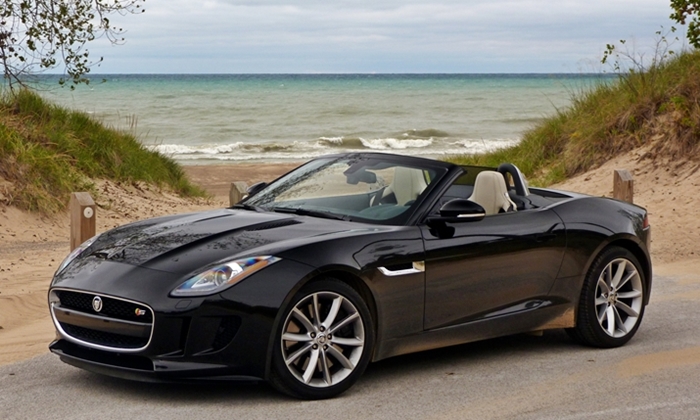
Photos of a black car fail to capture the F-Type's beauty. People love the look of this car. more F-Type photos
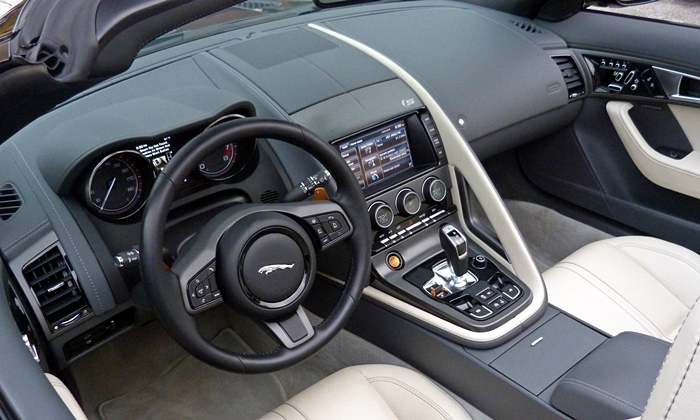
Jaguar interior feels roomy for a sports car.
| |
Compared to the Corvette |
| Exterior styling |
 Better
Worse
Better
Worse
|
Most people don't need this review to judge whether the F-Type merits its appelation. Their eyes see a strikingly beautiful exterior that, while muscular rather than delicate and not at all retro, clearly evokes the E-Type's classic curves. Classy sex-on-wheels is back.
In comparison, the latest Corvette's exterior is arguably overwrought, with many elements jostling for attention. Yes, each of the vents is functional, but less conspicuous ones could have served just as well. Body-color vents are at least an option for 2015, and this should help. Then again, some people might find the Jaguar's exterior styling overly subtle, and perfer the more aggressive shape of the Corvette. The Chevrolet's undulating hood does make for a more exciting view from the driver seat.
| Interior styling |
 Better
Worse
Better
Worse
|
Jaguar has always done a fine job with interiors, and the F-Type's is no exception. A $1,925 Extended Leather Pack covers nearly every surface from your elbows up with quality hides. The latest Corvette's interior is much better than its predecessor's, and can be similarly swathed in leather, but the Jaguar's remains more upscale and artful. Also, while both interiors are sportily styled, the Jaguar's--with a less aggressively raked windshield, an inch more shoulder room, a less curvy instrument panel, and a lower console--feels more open.
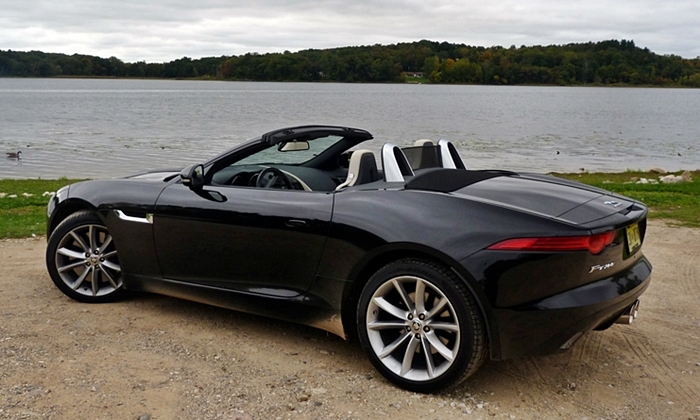
Top stows quickly and cleanly. Wind deflector between fixed roll bars.
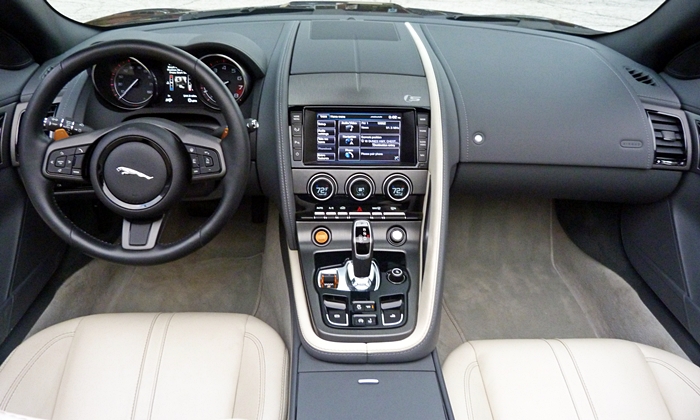
$1,925 Extended Leather Pack covers the instrument panel and windshield frame with stitched hides.
| |
Compared to the Corvette |
| Price or payments |
 Better
Worse
Better
Worse
|
The Jaguar F-Type has one obvious downside: price. With a 340-horsepower supercharged V6, the car starts just under $70,000. Stepping up to the 380-horsepower F-Type S and adding four highly desirable packages to get the features on the tested car puts the sticker over $92,000. Want the 495-horsepower supercharged V8? Add another $8,000, for a six-figure total.
There's little use for the additional power of the V8 in street driving, so I'll relax my usually strict apples-to-apples approach and compare the 380-horsepower F-Type S to the 460-horsepower Corvette, the latter in pricier Z51 form to get adaptive dampers (which are standard on the F-Type S). Even when cut this slack, the Jaguar lists for nearly $15,000 more.
Of course, Chevrolet's isn't the most prestigious badge. Any two-seater with the prestige as well as the power of the F-Type S will cost more, even much more. A similarly equipped Porsche Boxster costs a couple thousand less, but is significantly smaller and less powerful. So maybe the F-Type's price isn't so bad, after all. If the Corvette didn't exist it might even seem a bargain.
| Reliability & durability |
 Better
Worse
Better
Worse
|
Jaguar doesn't have the best reputation for reliability. For this reason, every time my father considered buying one he chickened out. We don't have much reliability data on Jaguars, as they sell in small numbers. What we do have, on the XF sedan, isn't encouraging. While the cars aren't dreadful anymore, they aren't often problem-free, either.
The Corvette had some first-year issues of its own, but these seem to be abating, and in the long-run it'll likely prove significantly less expensive to maintain.
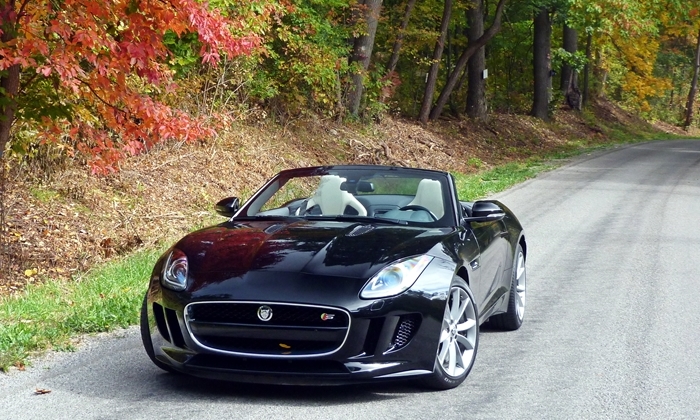
Face is clearly Jaguar.
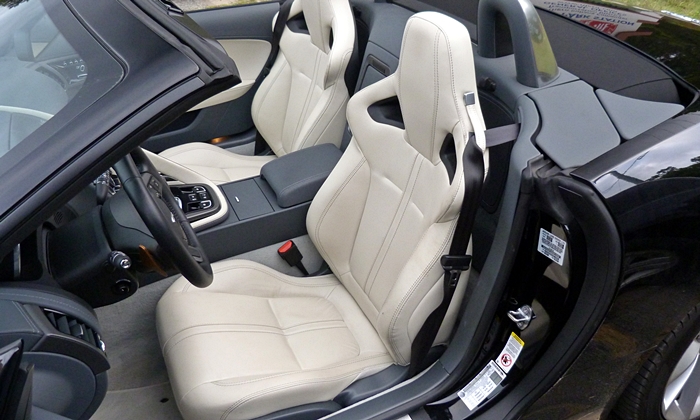
Optional performance seat has larger, power-adjustable side bolsters.
| Feature availability |
 Better
Worse
Better
Worse
|
The Corvette offers more driving modes for its more sophisticated electronic chassis controls. And a head-up display. And even a nav-linked video-plus-data recorder, with Cosworth-supplied analytic software, to capture and analyze your performance on road or track.
But the feature available in the Corvette that I missed most in the Jaguar is a manual transmission. While you can now get an eight-speed automatic in the Corvette, you have no other choice in the Jaguar.
| Cargo capacity |
 Better
Worse
Better
Worse
|
Trunks don't come much smaller than the F-Type's seven cubic feet. A small weekend bag barely fit in a well in the center. My computer bag sqeezed into the trunk's forward area. Unless the passenger seat is unoccupied, pack light. Or get the coupe--it can hold nearly 12 cubic feet between its hatch.
A Corvette convertible's trunk can hold ten cubic feet, a Corvette hatchback 15. This is the upside of the Chevrolet's bigger butt.
| Ride smoothness |
 Better
Worse
Better
Worse
|
On suburban Detroit's badly scarred roads, especially with the top up (isolating some sensations), the Jaguar's ride feels decidedly less than smooth. Toggling over to "dynamic" mode, which firms up the adaptive shocks standard in all save the base F-Type, increases the frequency of body motions more dramatically than it firms up the car's steering. If you're not carving some serious corners, you'll switch back. The various thumps and jiggles aren't vigorous, much less harsh, and so aren't uncomfortable, but they thwart relaxation. Would these motions become tiresome over the long haul, in the role of a daily driver? Perhaps, depending on road surface quality and one's tolerance for thumps and jiggles. I haven't driven the Corvette on similar roads, but others have reported that it better manages minor road imperfections.
Put the top down on a winding two-lane, and the F-Type's ride feels beyond fine. Plus the Jaguar feels more substantial than the Corvette, perhaps because it is. Compare both cars with V8s, and the 3,671-pound Jaguar, constructed mostly of aluminum, checks in 300 above the Corvette, which wears composite body panels over an aluminum structure.
Noise levels inside the F-Type aren't bad, either, unless you don't like exhaust noise (in which case the F-Type simply isn't the car for you). With the top down and the wind deflector in place between the roll bars, you'll experience minimal buffeting up to 65 mph or so. On a 70-mph freeway with temps in the mid-50s, I raised the side windows and lowered the seat a bit to get my scalp comfortably beneath the airstream. Airflow through the instrument panel vents could be stronger--I couldn't detect their output. The floor vents perform better, and the heated seats better still. But the F-Type lacks the neck-level vents offered in some Audi, BMW, and Mercedes convertibles. These would be welcome.
| |
Compared to the Corvette |
| Driving position & visibility |
 Better
Worse
Better
Worse
|
When not trying to duck beneath the airstream on the highway, I drove the Jaguar F-Type with the seat raised about an inch. With the seat in its lowest position I felt a little buried within the car, if not as much as in the Corvette. On the flip side, this should make the F-Type suitable for taller drivers (I'm 5-9). Ideally the instrument panel would be less massive and the pillars would be thinner, but their constraints on the view forward are much less evident with the top down.
The F-Type's optional performance seats aren't the absolute best I've experienced. Though their adjustable side bolsters provide plenty of lateral support, their bottoms are a touch firm for such an otherwise luxurious car. This said, I remained comfortable during a six-hour drive.
| Handling |
 Better
Worse
Better
Worse
|
The F-Type is so thoroughly enjoyable on winding two-lane roads that I'd list "fun to drive" among the reasons to buy one. Alas, that's not one of our categories, as "handling" and "powertrain performance" usually cover the same territory. The problem is--and this has me reconsidering our categories--sometimes objective and subjective performance diverge.
I can't list handling among the reasons to buy an F-Type because the Corvette and various Porsches will behave better and outpace the Jaguar on a technically challenging track. The Jaguar performs well, with accurate, well-weighted steering and minimal lean, dive, or squat. But the others have improved to a whole other level. Reviewers with driving skills well beyond mine report that they're much less tricky as they approach their higher limits.
One thing that makes the F-Type tricky at the track also makes it more entertaining at speeds achievable on public roads. Even with the V6 it's easy to steer the Jaguar with your right foot. Step up to the V8, with additional torque plus an active rear differential, and apparently the car can become a handful when hustled through curves with the stability control deactivated. The R model, available only in coupe form, further adds torque vectoring to the mix. This seems like overkill on a chassis already prone to oversteer.
A suggestion: don't turn off the stability control. On public roads I never felt it was cutting in too early or too hard; the system is programmed well for this sort of car. Also, unless maximum thrust is a top priority, stick with the six. When the throttle isn't affecting the attitude of the chassis, the V6 variants, with over a hundred fewer pounds in the nose, feel more balanced.
And more agile. "Agile" isn't a word I can often use with 3,600-pound cars. But the F-Type's quick steering and eager chassis deliver far more agility than any Jaguar in decades. The F-Type V8, with over 100 additional pounds in the nose, doesn't feel quite as agile as the V6, but still impresses in this regard. With either engine the car would be heavier if not for its aluminum body.
Best of all, the F-Type is one of those cars that simply feels right. Unlike a Porsche, which only communicates when pressed, the Jaguar talks to you all the time, telling you immediately what it thinks of each movement of the throttle and steering wheel. The Corvette is more like the F-Type than a Porsche in this regard, but even in it the driving experience isn't quite so visceral.
| Powertrain performance |
 Better
Worse
Better
Worse
|
The story is much the same with powertrain performance as with handling. Even with its 380-horsepower 3.0-liter V6 engine, the Jaguar F-Type S is capable of getting from a dead stop to 60 in about five seconds. Very quick by just about any measure. But the 460-horsepower Corvette can do the same in under four. (As can an F-Type with the 495-horsepower 5.0-liter V8.)
No one has tested the 340-horsepower base engine, but it shouldn't be much less quick than the S. After all, this is the same engine I found sufficiently strong in the far heavier Range Rover Sport.
Looking beyond full-throttle acceleration, the F-Type S's powertrain, while not the most refined, is reasonably well-behaved and always ready to do whatever you ask of it. Need to pass on a two-lane road, or merge onto the highway? With the supercharger boosting torque on demand (so you don't need to rev the engine like you would a high-winding Porsche) and the eight-speed automatic quickly grabbing the optimal ratio, either can be accomplished effortlessly. Yet, even though I often couldn't restrain my right foot, fuel economy averaged a respectable 24 mpg. Go easy on the gas in suburban driving, and high 20s are possible.
But these are cold, technical achievements. The F-Type's powertrain magic is in its immediate responses, and especially in its sound. Jaguar has tuned the sports car's exhaust to sing some of the most thrilling songs you'll hear from a current automobile without a fancy Italian badge. The system has two modes, with valves that open only under heavy acceleration. But if you want to hear the engine roar under lighter acceleration, hit a button on the center console. This button was a standalone $220 option with the 2014. With the 2015 it's part of a $3,400 Performance Pack that also includes, among other things, comfortable sport seats with adjustable bolsters (you want them).
For even more thrilling noises, find another $8,000 for the V8.
Even without the button, either engine awakes with a loud snort when you first start it and snaps, crackles, and pops on deceleration. There is no stealth mode. You're not driving anywhere unnoticed. But then you already knew this by looking at the car.
The latest Chevrolet Corvette is an incredible car. Compared to its predecessor, it performs better, drives better, and has a dramatically upgraded interior. Yet it still costs far less than European competitors, including the Jaguar F-Type. It's undeniably a bargain.
So why buy the F-Type? First off, there's the matter of styling. While the Corvette certainly isn't unattractive, I cannot imagine my father or his friends driving a car with so many look-at-me bits. I can easily imagine them in the relatively restrained yet strikingly beautiful F-Type. Also, while the Jaguar can't quite match competitors' test track numbers, it surpasses them in magic. It feels and sounds so alive. A connection forms readily between this car and your soul. When a car offers this, does the rest matter?
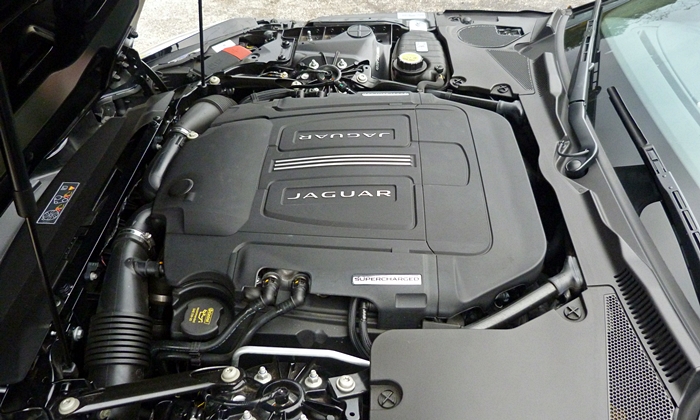
Hood opens forward to reveal...an engine cover. V6 plenty powerful.
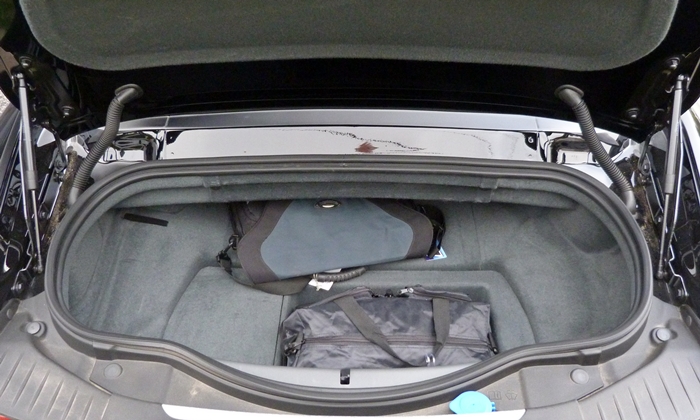
Pack lightly, the trunk holds only seven cubic feet. And no rear seat for extra cargo.
See more 2014 Jaguar F-Type photos
Jaguar provided an insured car for a week with a tank of gas. Jay Christian of Jaguar Asheville also provided a helpful earlier test drive. He can be reached at 828-891-7493. Chevrolet provided a car at a regional media association event.











